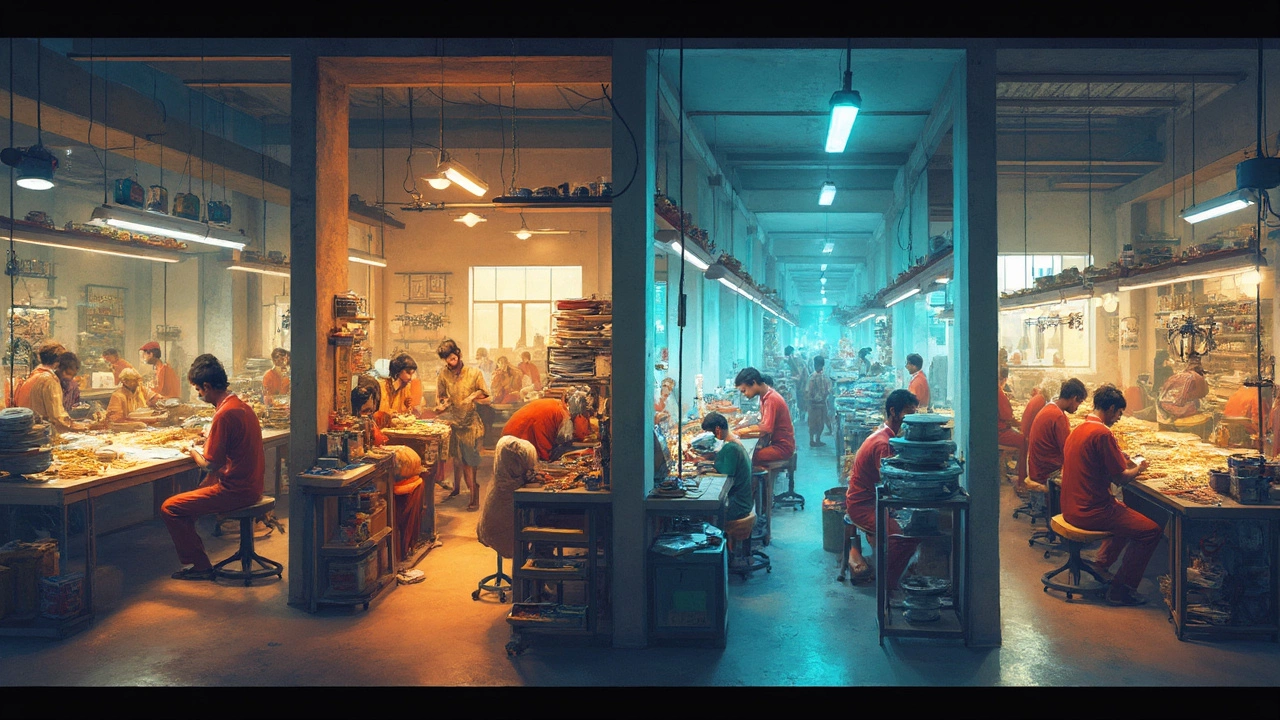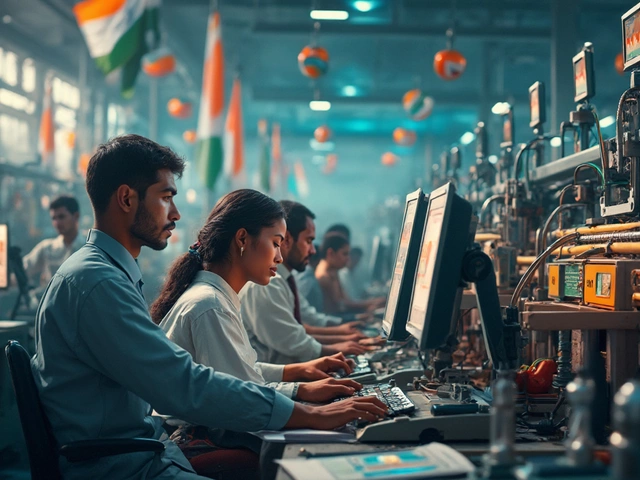Ever looked at your phone, furniture, or even a bag of chips and wondered how these things actually get made? It all comes down to the type of manufacturing system in play. Pick the wrong one, and you’ll end up with delays, waste, or products nobody wants. Get it right, and you unlock serious cost savings, more jobs, and even special government incentives.
Knowing your way around these four basic types isn’t just useful for factory owners. Plenty of government schemes tie their support and funding to what kind of manufacturing you use. Is your business small and custom-focused, or all about cranking out thousands of units a day? These answers can mean the difference between qualifying for a grant—or missing out.
- Why Manufacturing Systems Matter
- Job Shop Manufacturing
- Batch Production
- Mass Production and Continuous Production
- How Government Schemes Connect
Why Manufacturing Systems Matter
The type of system a factory uses shapes everything—from how much stuff it can pump out in a day to whether it produces custom parts or one-size-fits-all goods. It’s not just about machines and floor space. A manufacturing system really decides how fast problems get solved, how easy it is to change up a product, and how much waste shows up at the end. One smart switch in your system could save thousands or even millions every year.
Back when my son Kian and I visited a car factory, we saw first-hand how streamlined mass production means no wasted time. Conveyor belts zipped along, robots handled the heavy lifting, people only stepped in where brainpower was really needed. Compare that to a friend’s small woodworking shop nearby—not a line of 100 workers, just a few folks crafting special orders. That place needs a different system, one where flexibility beats speed.
Manufacturing systems also decide how much you can scale up if there’s more demand. Imagine a sudden spike in orders—if you can’t adjust, you lose out. Or picture lots of spoilage in food processing; the wrong system and you’re just tossing money, literally.
- If businesses choose a system that doesn’t match what they’re making, they end up with either bottlenecks or empty machines.
- Government schemes for manufacturing, like India’s Production Linked Incentive (PLI) schemes, often prioritize certain systems (for instance, automation-heavy ones) for higher payouts or faster application approval.
- Switching systems isn’t cheap or easy, so knowing your needs ahead of time saves a pile of money and headache down the line.
The takeaway? Matching your product, business goals, and funding opportunities means picking the right manufacturing setup—right from the start. It doesn’t just affect the bottom line, it can decide if a business gets left behind or leaps ahead.
Job Shop Manufacturing
Job shop manufacturing is the go-to system for custom jobs and smaller product runs. Think about your local metal workshop building special machine parts or a print shop making custom trophies. Each item moves through different machines and workstations in a unique pattern, so flexibility is the name of the game. This setup is popular with small businesses or companies handling unique orders, repairs, or prototypes.
Here’s what really sets job shops apart:
- Products are made one at a time or in small batches.
- Workflows change often, so machines and workers need to be adaptable.
- Skilled labor is super important—it’s not just about pushing buttons.
- You can easily switch to new products without massive retooling.
The main downside? Costs go up. Because everything’s custom, you can’t spread expenses over thousands of units like in mass production. Also, it can take longer to finish orders, especially when each one is different. But for many businesses working with clients who want something “just so,” the benefits win out.
Governments sometimes offer special training grants for this manufacturing system, especially if it keeps skilled jobs local—the kind of thing that helps a town’s economy. In India, for example, the MSME (Micro, Small & Medium Enterprises) scheme often favors job shops in engineering, printing, and tool-making for low-interest loans and subsidies.
| Feature | Job Shop Manufacturing |
|---|---|
| Best For | Low volume, high customization |
| Workforce Needed | Skilled, versatile |
| Machine Setup | Flexible, not specialized |
| Switching Products | Easy |
| Production Speed | Slow to moderate |
If you’re running—or planning to run—a business based on unique products or services, job shop manufacturing is probably your best bet. And with the right paperwork, you could tap into government help for training or equipment upgrades. Just make sure you keep up with skilled hiring and smart scheduling to get the most out of your shop.

Batch Production
Think about your favorite cookies—chocolate chip, oatmeal raisin, sugar. Bakeries don’t bake just one at a time. They make a whole tray, then switch to a new recipe. That’s basically how batch production works in the manufacturing world. It means making products in groups or "batches" instead of nonstop or one-by-one.
This approach is everywhere. Paint factories mix colors in batches. Textile companies dye large rolls of cloth at once, then move on to the next color. Breweries turn out one kind of beer, fill all the bottles, clean up, and prep for the next flavor. It’s a smart middle ground—flexible like custom job shops, but faster and more efficient.
Here’s why batch production is so handy:
- It adapts easily to product changes. You can switch ingredients, colors, or packaging with each batch.
- Equipment sits somewhere between simple and expensive—often machines that can run multiple jobs but don’t need huge investments.
- It keeps inventory in check. You don’t flood the market with too much product.
- If a batch turns out wrong, you only lose one group, not an entire day of work.
Let’s get concrete with a quick look at where batch production fits in, compared to other manufacturing systems:
| System | Volume | Flexibility | Cost per Unit |
|---|---|---|---|
| Job Shop | Very Low | High | High |
| Batch Production | Medium | Medium | Medium |
| Mass Production | High | Low | Low |
| Continuous Production | Very High | Very Low | Very Low |
In India, loads of small and mid-sized businesses use batch production because it matches government schemes tied to MSMEs (Micro, Small, and Medium Enterprises). For example, the government’s Credit Linked Capital Subsidy Scheme is easier to grab if you have flexible, batch-style lines—meaning you don’t need to risk everything on one product. If you’re planning to scale up, this way of working gives you breathing room and options.
So, next time you spot identical t-shirts in five different colors or see soap with limited-edition scents, know that batch production’s behind it. For manufacturers chasing both choice and savings, this system just makes sense.
Mass Production and Continuous Production
Here’s where you really see modern industry at work. Mass production means making huge numbers of the same product, fast. Think of car factories, soda bottling plants, or even smartphone assembly lines. The whole idea is to use machines, assembly lines, and a ton of automation so workers don’t repeat simple tasks by hand.
Henry Ford didn’t invent mass production, but the moving assembly line he introduced in 1913 changed everything. Suddenly, the time to build one Model T dropped from over 12 hours to just 93 minutes. Cheap, repeatable products for everyone—pretty wild compared to custom hand-built stuff.
Some stuff gets pushed even further, like in oil refineries or chemical plants, using continuous production. Here, machines run all day, every day. There’s no start or stop between batches. The same goes for electricity plants or paper mills. Getting the process right means less waste and lower costs per item over time.
- Assembly lines ramp up speed and efficiency.
- Automation means fewer errors and less reliance on manual labor.
- Reaching massive scale makes everyday products affordable.
On the flip side, it’s tough to make changes on the fly. Want to switch your soda flavor or redesign that car’s dashboard? Stopping the line costs a lot—and wastes materials.
For India, especially after the government rolled out the Manufacturing and Production Linked Incentive (PLI) schemes, companies in mass and continuous production have gotten serious support. These incentives help cover setup costs for new factories, new machinery, and training for workers. There’s a big push to make India a global factory for everything from cars to electronics.
| System Type | Best For | Change Flexibility | Typical Products |
|---|---|---|---|
| Mass Production | Very high volume, standardized goods | Low | Cars, packaged foods |
| Continuous Production | Nonstop, huge scale commodities | Very Low | Oil, chemicals, steel |
If you’re thinking about scaling up, remember these systems thrive on predictability and size. Changing something in the middle is a headache, but if you want to make millions of the same thing, this is how you get it done. Plus, more often than not, these systems open the door to government programs that boost your bottom line and help your business grow faster.

How Government Schemes Connect
If you run a business or plan to start one, knowing how manufacturing systems fit into government schemes can actually move the needle for you. In India, for example, the government doesn't just throw money at random businesses. They look for specific production systems—like mass production or small-scale batch setups—before giving out incentives.
Take the 'Production Linked Incentive (PLI) Scheme' as an example. It’s one of the biggest pushes in recent years. The government offers financial incentives to businesses that switch to mass production lines, especially in sectors like electronics, pharmaceuticals, and auto parts. The idea is simple: crank out large quantities, keep quality up, and you get rewarded.
But what if your business is more focused on made-to-order products? That's where schemes like the MSME (Micro, Small, and Medium Enterprises) support come into play. These are often tailored toward job shop and batch production, where flexibility and customization matter more than slugging out a million units a month. Government loans, credit guarantees, and even technology upgrades come easier when you fit the criteria.
Here’s a quick look at which type of manufacturing usually aligns with certain schemes:
| Scheme Name | Suited Manufacturing Type | Main Benefit |
|---|---|---|
| PLI Scheme (Electronics, Pharma, Auto Components) | Mass/Continuous Production | Financial Incentives |
| MSME Technology Upgradation Fund | Job Shop/Batch Production | Subsidized Loans |
| Start-up India | Batch Production/Job Shop | Tax Breaks, Easier Compliance |
| Make in India | All Types (with focus on Mass) | Investment Support |
Want a real-world tip? Figure out which group you fit into, then check the eligibility rules. For example, applying for the PLI demands you prove you can scale up production fast, while MSME support is happier to work with job shops or craft-focused setups.
Most schemes are now digital—you register online, upload your documents, and track your application status right from your laptop or phone. So, you don’t need a fixer or agent, just an understanding of how your manufacturing system aligns with the scheme’s focus. That’s the first real step toward getting those government benefits.






